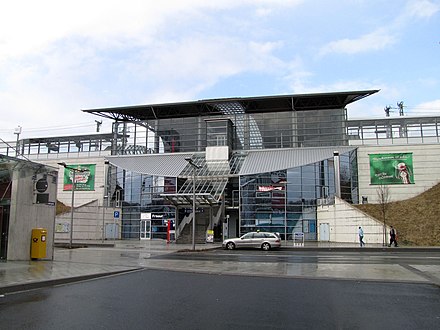German railway station categories
The train station category of DB Station & Service, a subsidiary of Deutsche Bahn, describes the importance of a railway station for passenger services and the service that is offered there based on various factors. About 5,400 stations and stops were divided into seven categories. The classification results from a number of criteria, including number of platforms, the train stops and passengers per day, accessibility and availability of service facilities
Earlier in Germany the station class was customary, in which stations were classified according to their importance in passenger and freight transport. Similar classification systems exist in other countries today.
Categories
The stations are grouped by DB Station and Service in the categorization system of 2013 in seven categories. The number of the respective stations refers to the level of 2013.
Category 1
To Category 1 includes the major train stations in Germany. Service staff are available, there are a number of shops in the station. In total there are 21 stations in this category. The cities of Berlin, Hamburg, Cologne and Munich have several stations of the highest category.
- Berlin Hauptbahnhof
- Berlin Ostbahnhof
- BerlinGesundbrunnen
- Berlin Suedkreuz
- Dortmund Hauptbahnhof
- Dresden Hauptbahnhof
- Dusseldorf Hauptbahnhof
- Duisburg Central
- Essen Hauptbahnhof
- Frankfurt (Main ) Hauptbahnhof
- Hamburg Hauptbahnhof
- Hamburg -Altona
- Hanover Central
- Karlsruhe Hauptbahnhof
- Cologne Central Station
- Köln Messe / Deutz
- Leipzig Hauptbahnhof
- Munich Central
- München Ost
- Nürnberg Hauptbahnhof
- Stuttgart Hauptbahnhof
Stations of Category 1 ( to 2011)
Stations of Category 1 ( to 2010)
Category 2
83 stations, holding the important long-distance transport ( with maintenance of intercity or Euro City trains ) are usually in large cities or allow access to a major airport are assigned to Category 2. Examples include the following stations:
- Augsburg Hauptbahnhof
- Berlin Zoological Garden
- Bonn Hauptbahnhof
- Braunschweig Hauptbahnhof
- Chemnitz Hauptbahnhof
- Cottbus
- Darmstadt Hauptbahnhof
- Erfurt Hauptbahnhof
- Halle Central
- Hamm ( Westphalia )
- Kassel- height
- Koblenz Hauptbahnhof
- Lübeck Main
- Magdeburg Hauptbahnhof
- Munich -Pasing
- Offenburg
- Oldenburg (Oldenburg ) Hauptbahnhof
- Rostock Hauptbahnhof
- Saarbrücken Hauptbahnhof
- Weimar
Category 3
The 220 stations (as of 2013) in category 3 are often " main stations of small to medium-sized cities ." On the " Regional nodes with possible long-distance traffic stop" / " Highway hold without overriding importance for regional traffic " there is usually a reception building, where passengers can buy tickets and food. In service staff is often omitted. Examples include the following stations:
- Bad Hersfeld
- Bergen auf Rügen
- Bitterfeld
- Celle
- Crailsheim
- Düren
- Eisenach
- Jena Paradies
- Kempten (Allgäu ) Hauptbahnhof
- Lichtenfels
- Limburg ( Lahn)
- Lutherstadt Wittenberg
- Marburg ( Lahn)
- Montabaur
- Mülheim (Ruhr ) Hauptbahnhof
- Paderborn Hauptbahnhof
- Oberstdorf
- Schorndorf
- Tuttlingen
- Zwickau (Sachs ) Hauptbahnhof
Category 4
The category 4 are assigned to about 600 stations. The stations designated as "highly frequented transit system maintenance / transport nodes " are primarily aimed at commuters often. At each of these stations also keep long-distance trains. Also rail stations or breakpoints that are served by one or more driving in dense clock lines are assigned to this category, which is not usually reflected in a relation to the categories 5 and 6 better equipment. Examples are the railway station Berlin light field West, the Leverkusen Mitte train station or the Elsterwerda station.
Category 5
Stations of Category 5 are often " smaller cities and numerous neighborhood stations". They are used a lot of commuters. There are approximately 1,040 (as of 2013) railway stations in this category, including: Station Post -Heng, station Köln - Holweide or station Hohen Neuendorf ( b Berlin).
Category 6
In category 6, 2500 stations " usually in sparsely populated areas " classified, their equipment is limited " to the bare essentials ". Examples: Ilmenau Train Station, Station Glöwen.
Category 7
The approximately 880 stations in the lowest category, often called " land holding " have the smallest number of travelers, and only the necessary for a breakpoint facilities. Examples: Zwotental station, railway station Goehrde
Stations by provinces
In the following lists you will find the currently managed by Deutsche Bahn stations, partially complete, partially up to and including Category 5:
- List of passenger stations in Schleswig -Holstein
- List of railway stations in the Free Hanseatic City of Bremen
- List of passenger stations in Mecklenburg -Vorpommern
- List of stations of the S- Bahn Hamburg
- List of passenger stations in Lower Saxony
- List of passenger stations in Brandenburg
- List of railway stations in the Berlin area
- List of passenger stations in North Rhine -Westphalia
- List of passenger stations in Hesse
- List of passenger stations in Thuringia
- List of passenger stations in Saxony -Anhalt
- List of passenger stations in Saxony
- List of passenger stations in Rhineland -Palatinate
- List of passenger stations in the Saarland
- List of passenger stations in Baden -Württemberg
- List of passenger stations in Bavaria


.jpg)






